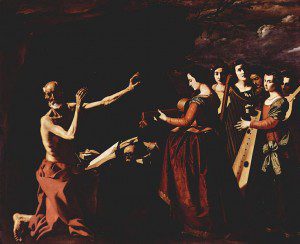 For many centuries, the pretext for official Church hostility to dreams and dreamwork was the deliberate mistranslation of a Hebrew word in the first Latin version of the Bible. This was known as the Vulgate, and was the official Catholic Bible for over fifteen centuries, until the mid-1960s.
For many centuries, the pretext for official Church hostility to dreams and dreamwork was the deliberate mistranslation of a Hebrew word in the first Latin version of the Bible. This was known as the Vulgate, and was the official Catholic Bible for over fifteen centuries, until the mid-1960s.
The translator was St Jerome (347-419), the child of a patrician Christian Italian family who became a desert monk and learned Hebrew after a terrifying dream in which he was lashed before the throne of a divine judge and berated for his interest in the classics.
The key word in Hebrew is anan. It can mean either “witchcraft” or “soothsaying”. In the Old Testament, it is always derogatory, suggesting low goetic magic and superstition, the work of fortune tellers and necromancers. The word anan appears ten times in the Old Testament. In making his Latin translation, Jerome correctly translated it as “witchcraft” seven times.
But in translating Deuteronomy 18:10 and Leviticus 19:26, Jerome rewrote the law, “You shall not practice augury or witchcraft” by giving a different meaning to anan. In these passages, he assigned the meaning “observing dreams”. So the law now read, “You shall not practice augury or observe dreams.”
Christian scholar Morton Kelsey observed that this mistranslation is curious and can hardly be disingenuous, in light of the fact that Jerome was an excellent scholar and correctly translated the term anan seven times. Kelsey concludes that the mistranslation may have been deliberate, perhaps inspired by Jerome’s frightening dream.
Over the next fifteen centuries, most translations of the Bible were derived from Jerome’s Latin, and not the original Hebrew, so the prohibition against using dreams as a source of guidance and healing – and of direct revelation, as seen in the Bible itself – was widely accepted by churches and compliant Christians without access to the original text. The New Oxford, New Jerusalem and other modern editions of the Bible have restored the original meaning of anan
Source: Morton Kelsey, God, Dreams and Revelation: A Christian Interpretation of Dreams (Minneapolis: Augsburg Publishing House,1991).
Image: Francisco de Zurbarán, Jerome in the desert, tormented by memories of the dancing girls of Rome (1639)

